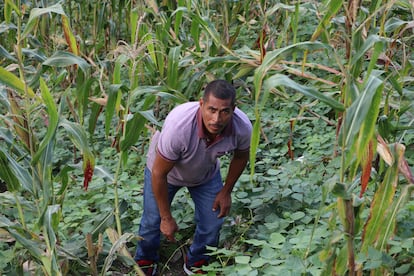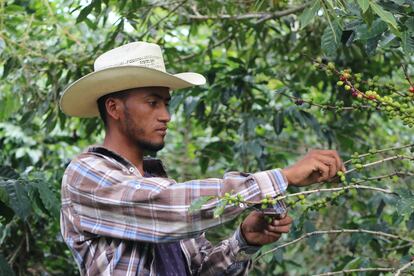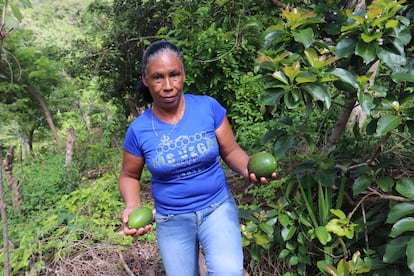Dragon fruit and sesame seeds: The Honduran Dry Corridor, a laboratory of resistance to the ravages of the climate
Faced with the dilemma of resisting or migrating, Central American farmers are testing crops that allow them to adapt to prolonged droughts and torrential downpours


With satisfaction, Francisco Rodríguez observes how his corn and beans finally prosper on the mountain slopes. He spent the last two years working in the United States to be able to afford it all: he had to pay off a $3,000 debt that he accrued when Hurricane Eta passed through this remote area, ruining the crops.
Rodríguez, 46, is a resident of the Tolupan Indigenous community, in the Yoro region of northern Honduras. Last year, he recalls, it was a drought that wreaked havoc. Weathered by the sun, he has just returned home. He’s continuing to gamble on the agricultural sector, despite the fact that the climate is increasingly unpredictable, and the future more uncertain.
Beans and corn are the basis of the average diet in Honduras, one of the countries that make up the Central American Dry Corridor, an area under enormous pressure due to climate change. It begins in Chiapas (Mexico) and reaches Guanacaste (Costa Rica), along the Pacific slope. More than 10.5 million people live in this region, which is filled with dry tropical forests and savannas. It’s increasingly affected by two extremes: prolonged droughts and excessive rainfall. A third of the inhabitants — those who grow basic grains for mere subsistence — require humanitarian aid, according to the Food and Agriculture Organization of the United Nations (FAO). Extreme weather events in recent years have increased vulnerability throughout the corridor.
Campesinos, or peasants — traditional subsistence farmers — make up 45% of the population of Honduras, a country of just over 10 million inhabitants. This percentage is similar in other Dry Corridor countries, such as Nicaragua, El Salvador and Guatemala. Traditionally, they harvest their yield twice a year. The first sowing is typically done in May and June — coinciding with the beginning of the rainy season — and is then repeated in October, when the rainfall is most intense.
Following the harvest, Rodríguez feels that things are going well. Still, he looks at his land and reflects on what’s been happening. “The usual dates no longer serve us. Everything has changed. The summer months seem like winter and vice-versa. It doesn’t rain for months and then, suddenly, we get downpours,” the farmer sighs. His plot is part of a project to bolster resistance to the extreme variations in the climate, by improving water management and diversifying crops. Now, on his land — in addition to day-to-day sustenance — there are also lemon and orange trees, which grow thanks to a drip irrigation system.

The climate crisis has put regions such as Yoro on the edge. The alternating phenomena of persistent droughts and torrential rains have endangered livelihoods, placing many farmers in a dilemma: hang on, or migrate.
Weighed down by debts stemming from poor yields, Rodríguez went into even more debt in the past to pay them off. He paid $15,000 to coyotes (guides) who helped him make his way to the United States. He recalls the stifling heat of the Mexican desert. “I arrived almost dead. But thank God I arrived. Many don’t make it. And now, I have a story to tell.”
Rodríguez settled in Dallas. During the day, he worked installing and repairing roofs. At night, he slept in a small apartment with eight compatriots. “If you want to make money, you can’t be comfortable.” He sent money to his family and to people in the community who asked him for help. Remittances account for 20% of Honduras’ GDP — they pay for the best, most comfortable houses in the rural areas of the country, which look American-style. Rodríguez never lost sight of his piece of land — isolated and remote, but his own — and returned three months ago with more knowledge about how to face the drought. His desire is to never have to move away from his wife, his three children and his two grandchildren. He doesn’t want to leave his Tolupan community.
More profitable crops
Others have never left. They try to address the shifts in the climate with innovative ideas, such as those explored by students at the Texiguat Agricultural Institute, located in the south of Honduras. Engineer Nelson Ariel Aguilera, 26, teaches classes to students who come from peasant families and don’t want to leave their land. This is an open-air laboratory, surrounded by mountains, where they experiment with different varieties of crops to find “those that are more resilient to the effects of climate change and, in particular, to the lack of rain,” Aguilera explains.
Pitaya (also known as dragon fruit) has given them great results. The same goes for sesame seeds. “They adapt to the area, they don’t require as much water or fertilization, they’re resistant. And, on top of that, they produce more [yields] and are much more profitable. For a load of sesame seeds, you earn three times more than what you get for a load of corn,” the engineer notes.
The challenge, he admits, is to “change the mentality of the families that have grown corn and beans from generation to generation.” That’s what his students are trying to do: they see that the usual formula isn’t working. If they want to live beyond mere subsistence, they have to change their methods. In the region of El Paraíso — where the institute is located — the first harvest of the year is often sacrificed. Everyone bets on the second, which occurs in the middle of the rainy season. In this part of the country — unlike in other territories — torrential downpour is a blessing.

Josué Noé, 23, is a student at the Texiguat Agricultural Institute. He’s one of the thousands of Hondurans who, when the second planting season is over, offers to go harvest coffee in the mountains. At the end of October, the trucks appear to look for labor. It’s a temporary, cyclical migration, often consisting of entire families. This pauses the schooling of children in rural areas. “It’s a way to help the family. It’s hard, you’re always under water, there’s rain every day,” Josué explains. You don’t charge by the hour, but by the amount of coffee cherries you’re able to collect. This must be done skillfully, for if the stem breaks, the fruit doesn’t grow again. This implies losses for the owner and, oftentimes, penalties for the collector.
Coffee in Central America has two faces: it’s hard work, but it’s also an alternative to escape poverty. Orlando Hernández waits proudly for EL PAÍS in front of his house, which is equipped with solar panels. “Look how bright it comes in,” he says, pointing out the fluorescent light that illuminates one of the rooms. His children, finally, can study at night, while he can charge his cell phone. The family is one of the 33 in the area that’s benefiting from an environmental improvement project: the kitchen — where a river fish dries, hanging on the wall — no longer generates soot, because it’s equipped with an improved stove that reduces firewood needs by 80%. Thanks to a purifying filter, the Hernández family can also drink water without fear of contracting diseases.
This 35-year-old farmer left aside beans and corn and switched to coffee. “They’re beautiful plants. When you come here, you feel happy,” he smiles, in the middle of his small plantation, which gives him esthetic pleasure. Above all, harvesting coffee has taken him out of poverty. When he was working with basic grains, he was earning 50 lempiras a day — about $2. Now, with coffee beans, he earns about 600 lempiras daily, or $24. “You think about the future of your children [he has three] and you don’t want them to suffer through what you suffered,” he says. While the harvesting season is intense, coffee provides work all year round. It’s done by taking care of the soil, so that resilience against climate change is increased. Hernández’ plot produces less than the large coffee plantations, but it’s more than enough.

Drought, an indirect cause of migration
“The Yoro valley is fertile, very productive. The largest quantity of basic grains in Honduras comes from here. But climate change is affecting it greatly. Before, the seasons were well marked, there were two seasons for planting. Not now,” Levy Daniel Icona emphasizes, inside a pickup truck that bounces along dusty roads. This expert from the Community Action Foundation of Honduras (FUNACH) confirms that, in 2023, the drought wreaked havoc. “It’s been devastating. There was hardly any production of corn or beans. More than 1,000 head of cattle died in the area, because they didn’t have food.”
The El Niño meteorological phenomenon causes droughts to last longer, which — in addition to affecting the capacity of mountain aquifers to replenish — often causes the prime harvest to be lost, due to lack of water. Many farmers give up that first sowing season, so as not to lose their investment. This, in turn, compromises food security. The degradation of soils also results in less ability to retain water. Hence, the countryside loses fertility and crops end up providing low yields, a combination that makes a sharecropper’s life increasingly precarious.
There were years of devastating drought — such as 2015 and 2016 — when Honduras lost 80% of the bean harvest and 60% of the corn harvest. At the time, UNICEF revealed that, in one of every three households in Honduras’ Dry Corridor, children were having to work. According to the 2020 report Climate Migration in the Dry Corridor of Central America, the renunciation of that first harvest is an example of “negative adaptation” to climate change, which forces many families to “reduce their consumption of goods, services and other investments in health and education.”

The United Nations Convention to Combat Desertification (UNCCD) has recently warned that 55 million people around the world are affected by drought each year. “It’s a global issue. Droughts are going to become more frequent and intense. That’s why we support countries to implement proactive policies,” explains Daniel Tsegay, a program manager at UNCCD. Tsegay points out that drought is a burden on the economy, which is why it’s advisable to prevent it. According to the International Drought Resilience Alliance (IDRA) — promoted by Spain and Senegal — investing to combat drought provides returns of up to 10 times the initial investment. Tsegay adds that drought is an “amplifier and catalyst” of migration. According to the World Bank, drought may force the migration of more than 200 million people by 2050.
Climate change is a direct cause of migration, according to studies by the International Organization for Migration (IOM). Drought, for example, causes poorer harvests, food insecurity and higher poverty rates. The lack of opportunity leads thousands of Central Americans to leave their countries. This is especially the case among rural young people, who “when they see that they cannot even buy their clothes with the classic harvest of corn or beans, they get frustrated and end up leaving, first to the cities [of Honduras] and then to the United States,” the FUNACH technician laments.
Women and coyotes
“We’re poor,” says Jorge, who only wishes for his first name to be used. He receives EL PAÍS in his home, in the rural area of Soledad, in the region of El Paraíso. In Honduras, the reality is that a good part of agriculture continues to be subsistence-based. Proud of a well that provides him with drinking water (“I’ve never gotten sick”), on his land, he has a little of everything: beans, fruit trees, chickens, tobacco leaves and, above all, paste (similar to giant zucchini), which contains a porous tissue inside that’s used as a sponge. That crop — which, 10 years ago, took him out of the most extreme poverty — “is declining and declining” due to the lack of rain. “When there’s no money, we hold on. The most important thing is food,” this farmer emphasizes. He eats beans for breakfast, eggs for lunch and “tender plantains” for dinner. Jorge appreciates the support of entities such as Ayuda en Acción (Help in Action), an NGO that helped him as he fenced his plot to keep predators away. “Before, all the wildcats ate [the crops and eggs]. So did the coyotes.”
Coyotes are a constant presence in Honduras. Especially those with a human appearance, who guide migrants on their way to the north. However, the middlemen who buy farmers’ products at a low price are also known by that name. Farmers often live in isolated areas and cannot move their merchandise, which ends up in large cities, such as Tegucigalpa or San Pedro Sula. It’s difficult to escape the coyotes.
In the community of La Albardía, in Yoro, a kind of matriarchy has come together, to farm in a more natural way. The women are gathered at the home of Isabel Murillo, a 51-year-old single mother. Her farm is in the middle of the sunny valley, where she has planted beans, vegetables, small hot peppers and, above all, avocados. Huge ripe avocados are falling from the trees. She’ll have to give these ones away, unless a coyote shows up and accepts her price.

This is a major barrier that they cannot overcome in La Albardía, or in many other rural communities. “The coyotes show up with cars and trucks to buy our products, because they know what we grow is good. And we can’t ship it out,” Blanca Gutiérrez acknowledges. She explains how — with the help of agricultural technicians — they have rescued several native varieties from oblivion, including types of plums, grapes, onions and corn. These offer small yields, but are more resistant to the area’s climate. The women only use organic fertilizer (based on manure and molasses) which they also sell. It’s good for the environment.
“With the traditional method, the soil becomes desertified. With the organic, the land improves, it comes to life,” Blanca affirms.
Experts explain that, while soil regeneration is slow, it’s unstoppable. The strip of organic matter is regenerated and, in the long-term, production grows, because the micronutrients are disseminated. What these women are doing is another form of resistance, the most effective in the long-term, in line with public policies for the Dry Corridor. Although coordinated action by governmental authorities is sometimes lacking, there are projects that offer results: on the land — via reforestation, the construction of terraces and furrows, waste management and prohibitions on burning crop debris — but also regarding water, with improvements to the supply and the installation of aquifers and cisterns.
Blanca boasts of living in the upper part of the valley, which is the rainiest. But she’s old enough to remember better times. “It rains much less than before. And the rains that used to be spread out over a year now fall suddenly. They’re downpours.”
This report has been filed with the support of the United Nations Convention to Combat Desertification (UNCCD) and ActionAid International.
Sign up for our weekly newsletter to get more English-language news coverage from EL PAÍS USA Edition
Tu suscripción se está usando en otro dispositivo
¿Quieres añadir otro usuario a tu suscripción?
Si continúas leyendo en este dispositivo, no se podrá leer en el otro.
FlechaTu suscripción se está usando en otro dispositivo y solo puedes acceder a EL PAÍS desde un dispositivo a la vez.
Si quieres compartir tu cuenta, cambia tu suscripción a la modalidad Premium, así podrás añadir otro usuario. Cada uno accederá con su propia cuenta de email, lo que os permitirá personalizar vuestra experiencia en EL PAÍS.
¿Tienes una suscripción de empresa? Accede aquí para contratar más cuentas.
En el caso de no saber quién está usando tu cuenta, te recomendamos cambiar tu contraseña aquí.
Si decides continuar compartiendo tu cuenta, este mensaje se mostrará en tu dispositivo y en el de la otra persona que está usando tu cuenta de forma indefinida, afectando a tu experiencia de lectura. Puedes consultar aquí los términos y condiciones de la suscripción digital.
More information

Fungi, yerba mate waste and cassava starch: Argentina’s alternatives to plastic
Archived In
Últimas noticias
There is as much life left to discover on planet Earth as that which is already known
Dozens presumed dead, around 100 injured in fire at Swiss Alps bar during New Year’s celebration
Is porn for women different from conventional porn? We spoke to those who make it
Cartagena de Indias is sinking: What can the city do to mitigate it?
Most viewed
- David King, chemist: ‘There are scientists studying how to cool the planet; nobody should stop these experiments from happening’
- Reinhard Genzel, Nobel laureate in physics: ‘One-minute videos will never give you the truth’
- Oona Chaplin: ‘I told James Cameron that I was living in a treehouse and starting a permaculture project with a friend’
- Sinaloa Cartel war is taking its toll on Los Chapitos
- The Interoceanic Train, the Mexican alternative to the Panama Canal









































